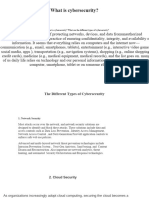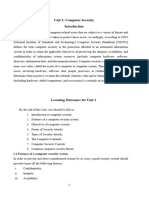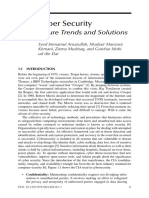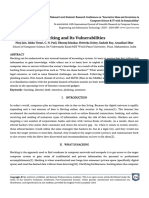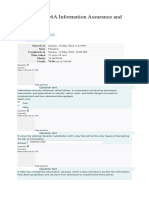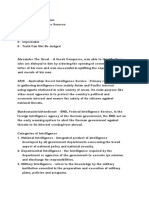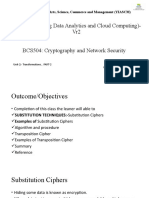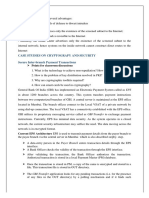0 ratings0% found this document useful (0 votes)
Nis
Nis
Uploaded by
Chaitanya KurandaleCopyright:
© All Rights Reserved
Available Formats
Download as PDF, TXT or read online from Scribd
Download as pdf or txt
Nis
Nis
Uploaded by
Chaitanya Kurandale0 ratings0% found this document useful (0 votes)
Copyright
© © All Rights Reserved
Available Formats
PDF, TXT or read online from Scribd
Share this document
Did you find this document useful?
Is this content inappropriate?
Copyright:
© All Rights Reserved
Available Formats
Download as PDF, TXT or read online from Scribd
Download as pdf or txt
0 ratings0% found this document useful (0 votes)
Nis
Nis
Uploaded by
Chaitanya KurandaleCopyright:
© All Rights Reserved
Available Formats
Download as PDF, TXT or read online from Scribd
Download as pdf or txt
You are on page 1/ 4
Q.
1 Attempt any Four
a) Write short note on DOS.
Ans: A DOS, or disk operating system, is an operating system that runs from a
disk drive. The term can also refer to a particular family of disk operating systems,
most commonly MS-DOS, an acronym for Microsoft DOS. An operating system
(OS) is the software that controls a computer's hardware and peripheral devices
and allows other software programs to function.
b) What is computer security and it’s need.
Ans: Computer network security is an important aspect in today's world. Now
days due to various threats designing security in organization is an important
consideration. It is essential to understand basic security principles, various
threats to security and techniques to address these threats.
c) Explain access control policies..
Ans: Considered a key component in a security plan, access control policies refer
to rules or policies that limit unauthorized physical or logical access to sensitive
data. An access control policy secures sensitive data and minimizes the risk of an
attack. Access control policies function by authenticating user credentials,
proving their identity, and allowing the pre-approved permissions associated with
their username and IP address.
d) Describe the term Identification and Authentication.
Ans: When user logged on to a computer, he performs two tasks.
Identification:- Enter username & password
Authentication : Prove that you are who claim to be
After entering & password, the computer will compare this input against the
entries stored in password
input Login is successful if username login is fail. password. is valid and if wrong
then login is fail
Many systems count the foil login attempts & prevent or deny next attemp when
threshold has been reached.
Now a day, many computer systems use identification & authentication through
username and password as first step of protection
e) Define virus and list any two types of virus
Ans: A computer virus is a program which can harm our device and files and
infect them for no further use. When a virus program is executed, it replicates
itself by modifying other computer programs and instead enters its own coding.
Boot Sector Virus - It is a type of virus that infects the boot sector of floppy disks
or the Master Boot Record (MBR) of hard disks. The Boot sector comprises all
the files which are required to start the Operating system of the computer. ne virus
either overwrites the existing program or copies itself to another part of the disk.
Direct Action Virus - When a virus attaches itself directly to a .exe or .com file
and enters the device while its execution is called a Direct Action Virus. If it gets
installed in the memory, it keeps itself hidden. It i also known as Non-Resident
Virus.
Q. 2 Attempt any Three
a) Define the terms i) Encryption ii) Decryption.
Ans: i) Enceyption-: Encryption is used to protect data from being stolen,
changed, or compromised and works by scrambling data into a secret code that
can only be unlocked with a unique digital key. Encrypted data can be protected
while at rest on computers or in transit between them, or while being processed,
regardless of whether those computers are located on-premises or are remote
cloud servers.
ii) Definition: The conversion of encrypted data into its original form is called
Decryption. It is generally a reverse process of encryption. It decodes the
encrypted information so that an authorized user can only decrypt the data
because decryption requires a secret key or password.
b) Explain Man-in- Middle attack with help of diagram.
Ans: A MITM attack is a form of cyber-attack where a user is introduced with
some kind of meeting between the two parties by a malicious individual,
manipulates both parties and achieves access to the data that the two people were
trying to deliver to each other. A man-in-the-middle attack also helps a malicious
attacker, without any kind of participant recognizing till it's too late, to hack the
transmission of data intended for someone else and not supposed to be sent at all.
In certain aspects, like MITM, MitM, MiM or MIM, MITM attacks can be
referred. If an attacker puts himself between a client and a webpage, a Man-in-
the-Middle (MITM) attack occurs. This form of assault comes in many different
ways.
c) Explain CIA Model of computer security
Ans: Explain CIA rule in computer security.
i. Confidentiality, integrity and availability, aho known as the CIA triad, in a
model designed to guide policies for information security within an
organization.
ii. The following is a breakdown of the three key concepts that form the CIA
triad:
iii. Confidentiality is coughly equivalent to privacy. Confidentiality measures are
designed to prevent sensitive information from unauthorized access attempts.
It is common for data to be categorized according to the amount and type of
damage that could be done if it fell into the wrong hands. More or less stringent
measures can then be implemented according to those categories.
iv. Integrity involves maintaining the consistency, accuracy and trustworthiness
of data over its entire lifecycle. Data must not be changed in transit, and steps
must be taken to ensure data cannot be altered by unauthorized people (for
example, in a breach of confidentiality)
v. Availability means information should be consistently and readily accessible
for authorized parties. This involves properly maintaining hardware and
technical infrastructure and systems that hold and display the information.
vi. Non-Repudiation is associated with verifying the identities of individuals or
companies who are participating in an on-line transaction. The main purpose
of authenticating identities online is to prevent one party or the other from
denying the transaction.
vii. Accountability is an essential part of an information security plan. The phrase
means that every individual who works with an information system should
have specific responsibilities for information assurance.
viii. Authentication is an access control method (s) used to verify the fentity of an
individual who is attempting to gain access into an information asset.
d) Describe piggybacking and shoulder surfing.
Ans: i) Shoulder surfing: It is using direct observation techniques, such as looking
over someone's shoulder, to get information. Shoulder surfing is a similar
procedure in which attackers position themselves in such a way as to- be-able to
observe the authorized user entering the correct access code.
• Shoulder surfing is an effective way to get information in crowded places
because it's relatively easy to stand next to someone and watch as they fill out a
form, enter a PIN number at an ATM machine, or use a calling card at a public
pay phone. Shoulder surfing can also be done long distance with the aid of
binoculars or other vision-enhancing devices.
ii) Piggybacking: Piggybacking on Internet access is the practice of establishing
a wireless Internet connection by using another subscriber's wireless Internet
access service without the subscriber's explicit permission or knowledge.
You might also like
- CEH: Certified Ethical Hacker v11 : Exam Cram Notes - First Edition - 2021From EverandCEH: Certified Ethical Hacker v11 : Exam Cram Notes - First Edition - 2021No ratings yet
- Keys For @emon9138: TRON Public Key (TRON Address)33% (3)Keys For @emon9138: TRON Public Key (TRON Address)2 pages
- Cybersecurity Internship Report Aicte: Computer Science Engineering (Kallam Haranadhareddy Institute of Technology)No ratings yetCybersecurity Internship Report Aicte: Computer Science Engineering (Kallam Haranadhareddy Institute of Technology)21 pages
- Internet Security: Common IT Security MeasuresNo ratings yetInternet Security: Common IT Security Measures7 pages
- Unit: Cybersecurity Fundamentals (Cit 4206) : Question OneNo ratings yetUnit: Cybersecurity Fundamentals (Cit 4206) : Question One4 pages
- Cyber Security Interview Questions For Freshers: 1. What Is The Main Objective of Cyber Security?No ratings yetCyber Security Interview Questions For Freshers: 1. What Is The Main Objective of Cyber Security?24 pages
- Mobile Computing Is An Emerging Technology That Serves Users at Anytime AndanywhereNo ratings yetMobile Computing Is An Emerging Technology That Serves Users at Anytime Andanywhere9 pages
- Computer and Network Security Notes Bca 6 Semester: Unit 1No ratings yetComputer and Network Security Notes Bca 6 Semester: Unit 153 pages
- Lesson 7 E-Commerce Security and Fraud ProtectionNo ratings yetLesson 7 E-Commerce Security and Fraud Protection26 pages
- Cybersecurityinterviewpreparatitions 240220171100 821b8b03No ratings yetCybersecurityinterviewpreparatitions 240220171100 821b8b0328 pages
- Top Cybersecurity Interview Questions and Answers For 2024No ratings yetTop Cybersecurity Interview Questions and Answers For 202425 pages
- Module in Information Management SystemNo ratings yetModule in Information Management System35 pages
- Polytechnic University of The Philippines: Prof. Florante AndresNo ratings yetPolytechnic University of The Philippines: Prof. Florante Andres5 pages
- College Trigonometry, Sixth Edition (PDFDrive)No ratings yetCollege Trigonometry, Sixth Edition (PDFDrive)93 pages
- Secure Data Deduplication and Auditing For Cloud Data Storage 1 1No ratings yetSecure Data Deduplication and Auditing For Cloud Data Storage 1 14 pages
- Information Assurance and Security 2 Prelim Lec Exam Answers 70%100% (1)Information Assurance and Security 2 Prelim Lec Exam Answers 70%13 pages
- EAadhaar 2086152120322820220303155145 21112023113627No ratings yetEAadhaar 2086152120322820220303155145 211120231136271 page
- VIII Sem IT Syllabus 2021-22290322115311No ratings yetVIII Sem IT Syllabus 2021-222903221153119 pages
- 1.5 2022 ThorTeaches CC Study Guides Chapter 5 v1No ratings yet1.5 2022 ThorTeaches CC Study Guides Chapter 5 v136 pages
- D2 COMMSEC - Breaking Siemens SIMATIC S7 PLC Protection Mechanism - Gao JianNo ratings yetD2 COMMSEC - Breaking Siemens SIMATIC S7 PLC Protection Mechanism - Gao Jian23 pages
- A Novel Image Encryption Algorithm Based On Chaotic System and DNA ComputingNo ratings yetA Novel Image Encryption Algorithm Based On Chaotic System and DNA Computing25 pages
- Dynamic Point To Point IPSEC VPN Tunnels Using DTVIs (GNS3 Lab)No ratings yetDynamic Point To Point IPSEC VPN Tunnels Using DTVIs (GNS3 Lab)5 pages
- v1 Kode Script Hack FB HTML Inspect ElementNo ratings yetv1 Kode Script Hack FB HTML Inspect Element1 page
- CEH: Certified Ethical Hacker v11 : Exam Cram Notes - First Edition - 2021From EverandCEH: Certified Ethical Hacker v11 : Exam Cram Notes - First Edition - 2021
- Keys For @emon9138: TRON Public Key (TRON Address)Keys For @emon9138: TRON Public Key (TRON Address)
- Cybersecurity Internship Report Aicte: Computer Science Engineering (Kallam Haranadhareddy Institute of Technology)Cybersecurity Internship Report Aicte: Computer Science Engineering (Kallam Haranadhareddy Institute of Technology)
- Unit: Cybersecurity Fundamentals (Cit 4206) : Question OneUnit: Cybersecurity Fundamentals (Cit 4206) : Question One
- Cyber Security Interview Questions For Freshers: 1. What Is The Main Objective of Cyber Security?Cyber Security Interview Questions For Freshers: 1. What Is The Main Objective of Cyber Security?
- Mobile Computing Is An Emerging Technology That Serves Users at Anytime AndanywhereMobile Computing Is An Emerging Technology That Serves Users at Anytime Andanywhere
- Computer and Network Security Notes Bca 6 Semester: Unit 1Computer and Network Security Notes Bca 6 Semester: Unit 1
- Cybersecurityinterviewpreparatitions 240220171100 821b8b03Cybersecurityinterviewpreparatitions 240220171100 821b8b03
- Top Cybersecurity Interview Questions and Answers For 2024Top Cybersecurity Interview Questions and Answers For 2024
- Polytechnic University of The Philippines: Prof. Florante AndresPolytechnic University of The Philippines: Prof. Florante Andres
- Secure Data Deduplication and Auditing For Cloud Data Storage 1 1Secure Data Deduplication and Auditing For Cloud Data Storage 1 1
- Information Assurance and Security 2 Prelim Lec Exam Answers 70%Information Assurance and Security 2 Prelim Lec Exam Answers 70%
- EAadhaar 2086152120322820220303155145 21112023113627EAadhaar 2086152120322820220303155145 21112023113627
- D2 COMMSEC - Breaking Siemens SIMATIC S7 PLC Protection Mechanism - Gao JianD2 COMMSEC - Breaking Siemens SIMATIC S7 PLC Protection Mechanism - Gao Jian
- A Novel Image Encryption Algorithm Based On Chaotic System and DNA ComputingA Novel Image Encryption Algorithm Based On Chaotic System and DNA Computing
- Dynamic Point To Point IPSEC VPN Tunnels Using DTVIs (GNS3 Lab)Dynamic Point To Point IPSEC VPN Tunnels Using DTVIs (GNS3 Lab)



















